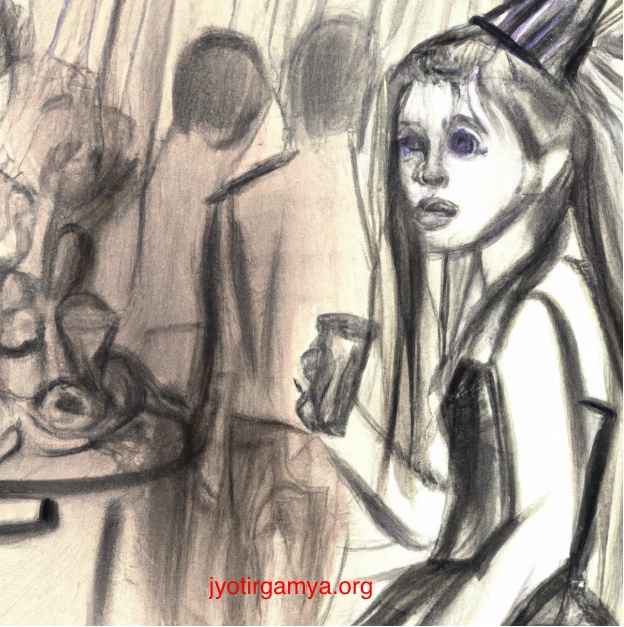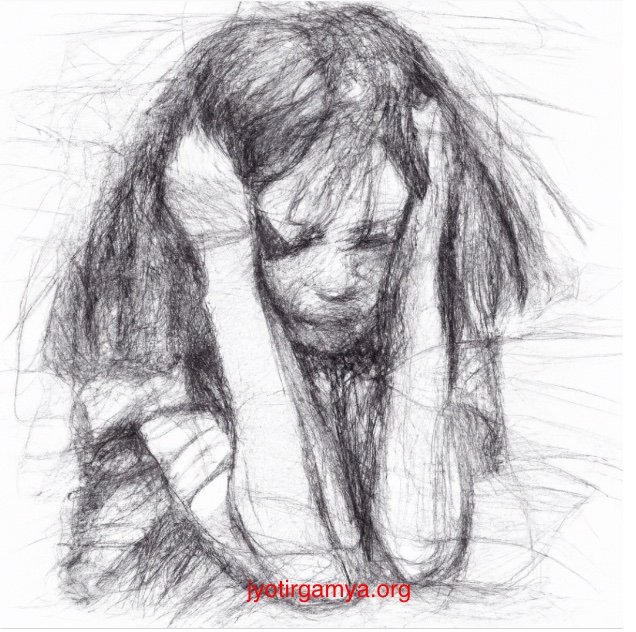How to Deal with Anxiety: Expert Advice and Techniques
Story
In the quaint village of Bullsville, situated amidst the idyllic countryside, a young woman named Pamela lived. She was a kind-hearted soul with a gentle demeanor and a warm smile that could light up even the darkest days. On this particular day, it was her birth anniversary, and she had plans to celebrate with her friends in the nearby city of Dramatown.
Despite the excitement, a sense of unease had settled deep in her chest, a feeling of impending doom that threatened to spoil her joy. But even as she carefully picked out her dress and applied her makeup, unease gnawed at her heart. She felt like she was walking on a tightrope, one misstep from tumbling into an abyss of uncertainty and doubt.
As the clock struck 6:30 PM, Pamela stood before her wardrobe, carefully selecting the finest attire to adorn her form. She fastened her high heels, striving to add a few inches to her stature, and then applied her makeup. Though she looked fair, she doubted her appearance and used lighter lipstick to appease critics.
With her clutch in hand, Pamela looked into the mirror, hoping to find a countenance that would please her.
But alas, even with all the effort she had put in, she could not shake the feeling of inadequacy that lingered within her. She crossed her fingers and prayed for the best as she exited her mansion.
Upon arrival at the venue, Pamela hesitated to interrupt her friends’ photo session, fearing she would be an annoyance. So instead, she waited patiently until someone noticed her and called her over.

As they sat down to dine, Pamela nibbled at her food, cautious not to leave any crumbs on her lips. Instead, she waited for her friends to finish their meals, too anxious to walk over to the dessert table a mere 20 feet away.
And throughout the evening, she was consumed by anxiety and self-doubt, second-guessing every word she spoke and every move she made.
When the meal ended, Pamela measured her steps to the counter, worrying that her every move was being scrutinized. She could feel the weight of her friends’ eyes upon her, and the thought made her uneasy. It would make an awkward situation if she stumbled.
Once she returned home, she sent a message to the group, waiting anxiously for a reply. And as the minutes stretched into hours, she felt the weight of her inadequacy pressing down upon her like a heavy stone.
When none came, she began to feel uneasy, unsure if she had picked the right venue or offended her friends in any way. The anxious thoughts swirled in her head, a never-ending stream of self-doubt and insecurity. She starts becoming uncomfortable, insecure, and anxious and tries to analyze,
“What if I needed to pick the right venue?”
“Did I offend them?”
“Do they hate me?”
“Are they ever going to reply to me?”
“Did something happen to them?”
A message notification breaks the thought train. She trembles as she opens the messaging app to read the text - “It was all good.”
The cruel grip of anxiety had taken hold of Pamela’s heart, squeezing it tight with a relentless grip. Despite her education and upbringing, she felt lost and alone, a prisoner of her thoughts and fears. And though she tried to shake off the relentless barrage of self-doubt, it clung to her like a shadow, always lurking at the edges of her consciousness.
As she lay in bed, Pamela questioned her over-analysis, wondering if her emotions were genuine or merely a cry for attention. But the questioning never stopped, leaving her with overwhelming despair.
She asked herself,
“Why am I like this?”
“Why am I not like her?”
“I should try harder.”
“I am such a loser!”

Daily worries, constant flight or fight mode, intrusive thoughts, and nervousness are everyday issues for someone with anxiety. A never-ending struggle leaves one gasping for each breath, feeling trapped in a world closing in. It is a cruel punishment, an endless curse that leaves one feeling alone and isolated, struggling to find a way out of the abyss of despair.
For Pamela, it is a curse, a punishment that erodes her sense of self and leaves her feeling isolated and alone. There are no visible signs of affliction, fever, rashes, or outward injury. Instead, it is a gradual erosion of the soul, a creeping rot that devours from within.
And even as she struggled to maintain a brave face, she knew the battle was far from over. But she refused to give up, clinging to the hope that one day, she might break free from the chains that bound her and find a measure of peace in this turbulent world.
Introduction
Anxiety is a common experience that can significantly impact an individual’s physical and mental health. While managing anxiety is essential, the severity of the anxiety experienced will determine the measures needed to reduce it. For some, seeking professional help may be necessary, while others may benefit from exercise, meditation, social support, and enjoyable activities. Identifying anxiety is the first step to managing it. Let us hear in detail how to manage anxiety.

Expert Advice
“Stress is a common experience for everyone, but how each individual responds can vary. Therefore, managing anxiety should be tailored to each person’s anxiety level. Experiencing excessive anxiety can adversely affect both physical and mental health, so it’s essential to identify the level of anxiety one is experiencing and take steps to reduce it.
The severity of one’s anxiety will determine the extent of the measures needed to reduce it. If anxiety significantly affects day-to-day functioning, seeking professional help may be necessary. For those experiencing lower anxiety levels or looking to maintain daily well-being, exercise, meditation, seeking social support, and engaging in enjoyable activities can be helpful.”
“Anxieties stem from our thoughts based on our perception and belief system.
A person needs to acknowledge that he is anxious.
Understand why they are anxious ( Trigger)
Analyse where the trigger is coming through.
Differentiate whether it is just a Mirage/factoid or Genuine.
If the trigger is Genuine, then understand what is controllable and what is not.
Controllable Genuine anxiety Students are anxious before exams; they need to work on study plans and engage professional help if required, like hiring a maths tutor for a particular subject, etc., which enhances self-confidence and esteem and eventually reduces their anxiety.
Uncontrollable Genuine anxiety.
In the above example, if a student develops anxiety that a paper might be difficult, a computer breakdown might happen, or any other extraneous reasons like a pandemic, we counsel that as part of CBT. There is an equal probability for the best and worst events to happen.
Assign your favorite color to the best and any other color to the worst.
Write the following positive affirmations in a big font in your favorite color and see the color. Tell yourself as many times as possible.
I can do the best
I will do the best
I am doing my best
What if Anxiety Is just Mirage or a factoid?
Anxiety arising out of Mirage leads to destructive phobic thoughts and often needs structured behavioral therapy like a combination of Dialectical behavioral therapy and Neurolinguistics programming.
For example, if Neena’s friend’s mother was detected with cancer
Anxiety often might result from underlying Psychiatric conditions like obsessive compulsion disorder, schizophrenia, acute depression, and other neurological disorders like Dementia, Alzheimer’s, etc.
For example, what if Neena’s friend’s mother detected cancer? Then if Neena developed anxiety out of factoids or mirages, thought like
What if my mother gets cancer?
What if she dies?
What if my father died?
What will happen to me?
What if I get into depression?
What if I had to discontinue everything?
The infinite what-if is called catastrophic thinking, a cognitive distortion that leads to endless anxiety. In such cases, cognitive behavioral therapy like Dialectical behavioral therapy and Neurolinguistics linguistic programming help Neena in Reframing her thoughts and rehauling her perception and belief system.”
“To start with, identifying anxiety is the first crucial step. Common symptoms include a constant fear or dread that may or may not be tied to a specific source. This underlying fear can interfere with daily activities. Other symptoms may include rapid heartbeat, palpitations, increased breathing, insomnia, and mental and physical fatigue, particularly when anxiety is experienced for an extended period.
Various techniques can be used to alleviate anxiety. Journaling is an effective way to release excessive thoughts and emotions from the mind. Deep breathing techniques can be done while sitting, lying, or strolling. Meditation can help to reset the mind and bring mental relief and relaxation. Maintaining a healthy diet and engaging in regular exercise can aid in getting good quality sleep, which can help to alleviate anxiety and fatigue. Yoga is also an excellent practice that combines deep breathing and movement to promote presence and relaxation.
As someone who has overcome anxiety and depression through research, I understand the potential for personal growth and self-discovery. I work with professionals who struggle with anxiety to help them overcome it and gain clarity in their lives, unlocking their full potential. Guiding my clients through their personal development journey to achieve their goals is something I’m passionate about.”"
“Anxiety management is best dealt with by a licensed Clinical Psychologist who knows the clinical picture of a disorder, personality patterns, and dynamics involved in the condition.
It usually starts with detailed case history which gives a deep understanding of the onset, responsible factors for the condition, and any hereditary and supporting factors in the treatment.
Cognitive Behaviour Therapy is the most used Psychotherapy in the management of anxiety and related disorders.
CBT needs regular weekly sessions Upto 3months or more depending upon personality type, psychosocial factors, and therapy compliance. After regular therapy sessions we usually put clients on maintenance therapy to prevent relapse in the future.”
“Willing things that cannot be willed create anxiety. Can’t will sleep, can’t will remembering, can’t will an erection. Stage fright is also anxiety. Pretending that you are someone you are not.
The organ of the will is the musculature. If I want you to like me, I’ll be anxious — either you will or you won’t, I can’t make you!
Learn to be willing, stop being willful, and you won’t generate anxiety.”

“Anxiety is a widespread issue that affects many individuals, yet it often goes unnoticed or untreated. To effectively manage anxiety, a multifaceted approach is necessary, which includes the following elements:
-
Engaging in regular exercise
-
Maintaining a healthy diet and sleeping habits
-
Practicing relaxation techniques
-
Cultivating mindfulness
-
Accepting oneself and one’s limitations
-
Being willing to confront the consequences of one’s actions
-
Addressing perfectionism
-
Overcoming feelings of vulnerability
-
Challenging negative thoughts
By implementing these strategies, individuals can learn to manage their anxiety and improve their overall well-being effectively.”
Conclusion
In conclusion, anxiety is a complex issue, and it is crucial to identify the level of anxiety one is experiencing and take steps to reduce it. Depending on the severity, different measures may be required, such as seeking professional help or engaging in various techniques to alleviate anxiety. Identifying anxiety symptoms is the first crucial step, and various techniques, including journaling, deep breathing, meditation, a healthy diet, regular exercise, and yoga, can alleviate anxiety.
Seeking the help of a licensed Clinical Psychologist is advisable for effective anxiety management, with Cognitive Behaviour Therapy being the most widely used psychotherapy for managing anxiety and related disorders. Acknowledging that controlling things outside our control can lead to anxiety is essential. Our ability to control things is closely tied to our musculature or physical strength and control.
Related Articles :
If you liked reading the article, do share it with folks who would benefit from it.
Want to stay connected? Here’s our twitter.